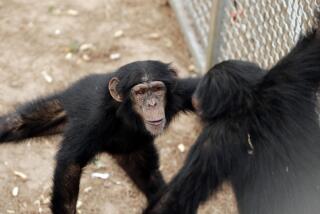Chimps Use Sex to Retain Group Bonds
- Share via
Ever since Jane Goodall observed some common chimpanzees fishing with straws for termites, tool-using has been dropped as the single, special trait that distinguishes humans from other animals. In its place, some anthropologists suggest that it is sexuality, especially sexual intercourse where there is no chance of fertilization, along with the supposed constant accessibility of the human female, that explains why our species was able to evolve such a complex culture.
These folks should visit the San Diego Zoo. A few hours watching Louise, Lana, Lenore, Vernon and Victor will make them reconsider. Louise and her companions belong to a rare species--pygmy chimpanzees (Pan paniscus), of which there are fewer than 40 in captivity. Their behavior casts doubts upon the uniqueness of our sexual behavior but does suggest a great deal about our evolutionary antecedents.
Although anthropologists disagree whether pygmy chimps deserve a genus of their own or are only a separate species of chimpanzee, they agree that Pan paniscus are special. Should you see both kinds of chimps side by side, you would have no trouble telling them apart. Lenore and Louise have darker skin and hair, longer legs, narrower chests, a different distribution of muscles and are smaller than common chimps. But it is their behavior that is especially curious.
The first pygmy chimp that we know of was adopted by American psychologist Robert Yerkes in 1923. Dubbed Prince Chim, he performed more quickly and sensitively on a host of IQ tests than the young female chimp, Pansy, with whom he was purchased. Yerkes did not know that Chim represented a different species and so described him as a “Genius chimp, a sport.”
Today we recognize that all pygmy chimpanzees seem like geniuses in comparison to their common cousins. They are far more social and are almost constantly interacting with one another. On a typical day at the zoo, for instance, 15-year-old Louise may interrupt her search for food, or her rough-and-tumble play with the toddler Victor in order to exchange genital rubbings with her daughter, Lenore. Female pygmy chimps frequently have sexual relations with each other. Or often, Louise may stop to copulate with Vernon or Victor no matter what stage she is at in her reproductive cycle, or even if she is already pregnant. And unlike the common chimp, when Louise copulates, she faces her partner and stares him in the eyes.
Pygmy chimps in the wild behave very much like Louise and her group in captivity. Japanese primatologist Suehisa Kuroda, who has studied them for more than a decade in their increasingly small habitat on the south side of the Congo River in Zaire, has explored this behavior. Initially he was startled by the intensity and frequency of the sexual contacts between the different members of the chimp community. Eventually, he understood that there was a reason for it. These animals live in large groups in close contact with each other. The constant sexual contact is an evolutionary adaptation that enables them to get along peacefully.
When there is a new source of food, Kuroda notes, the animal who has it gives a portion to a beggar, and then copulates with the beggar to relieve the tensions that have arisen over who would get what to eat. Sexuality, he suggests, is the way these highly social, highly intelligent animals assure each other that they mean no harm. This frequent homosexual and heterosexual activity is crucial to retaining bonds within the community and is distinct from the role of sex in perpetuating the species.
Standing about 3 1/2 feet tall, Louise is about the same size as Lucy, the fossil thought to be our earliest known ancestor. Louise is a very unusual chimp but she is still an ape. We know she is not identical to Lucy, but Louise may be the best living prototype of our prehominid ancestors. She is so like us, and yet so different.
The search for a single distinctive trait separating us from them is probably a mistake. Where we differ is a matter of degree. Sexuality and sexual play enables groups of animals that are not related to each other to interact peacefully. Homo sapiens, of course, evolved a high level of intelligence and with it transformed the simple sexuality that functioned as an anxiety-releasing mechanism in pygmy chimpanzees into the complex of emotions that some of us have experienced as love and others express as art.
More to Read
Sign up for Essential California
The most important California stories and recommendations in your inbox every morning.
You may occasionally receive promotional content from the Los Angeles Times.










